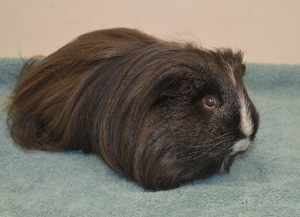
March comes in like a lion and goes out like a lamb, as the saying goes. But for us March was all about guinea pigs as they were our featured Animal of the Month! We tweeted interesting facts about these charming animals throughout March on our Twitter feed @ExoticPetVets. Here is a summary of our tweets in case you missed them. Did you know?:
- Domestic guinea pigs (Cavia porcellus) are descended from wild guinea pigs of South America.
- If handled often and gently, guinea pigs make great pets. They are lively, responsive, gentle and they rarely bite.
- It’s believed guinea pigs were domesticated in South America between 500 and 1000 AD – and possibly as early as 5000 BC.
- Guinea pigs are social and may be kept with others. But ensure the cage is the largest available to prevent overcrowding.
- Guinea pigs are rodents, but they have something in common with primates – they need vitamin C in their diet.
- Guinea pig pellets contain vitamin C, but the vitamin only remains active for 90 days from the date the feed was milled.
- Add a powdered vitamin C supplement or pediatric liquid to guinea pig’s water daily (1g/L). Water should be changed daily.
- Pet stores carry Vitamin C supplements for guinea pig’s water. Or get vitamin C chews if they won’t drink vitamin C water.
- Guinea pigs belong to the rodent group hystricomorphs, which have a strange reproductive physiology and breeding strategy.
- Hystricomorph rodents begin pregnancy with a large number of fetuses. Many die before birth, possibly due to food supply.
- Guinea pigs live to about 5 – 6 years of age. Males are called boars and females are called sows.
- Guinea pigs have been used in experiments for centuries; thus, the term “guinea pig” is a metaphor for a test subject.
- Guinea pigs were eaten by the Incas and are still used as food in many parts of South America today.

